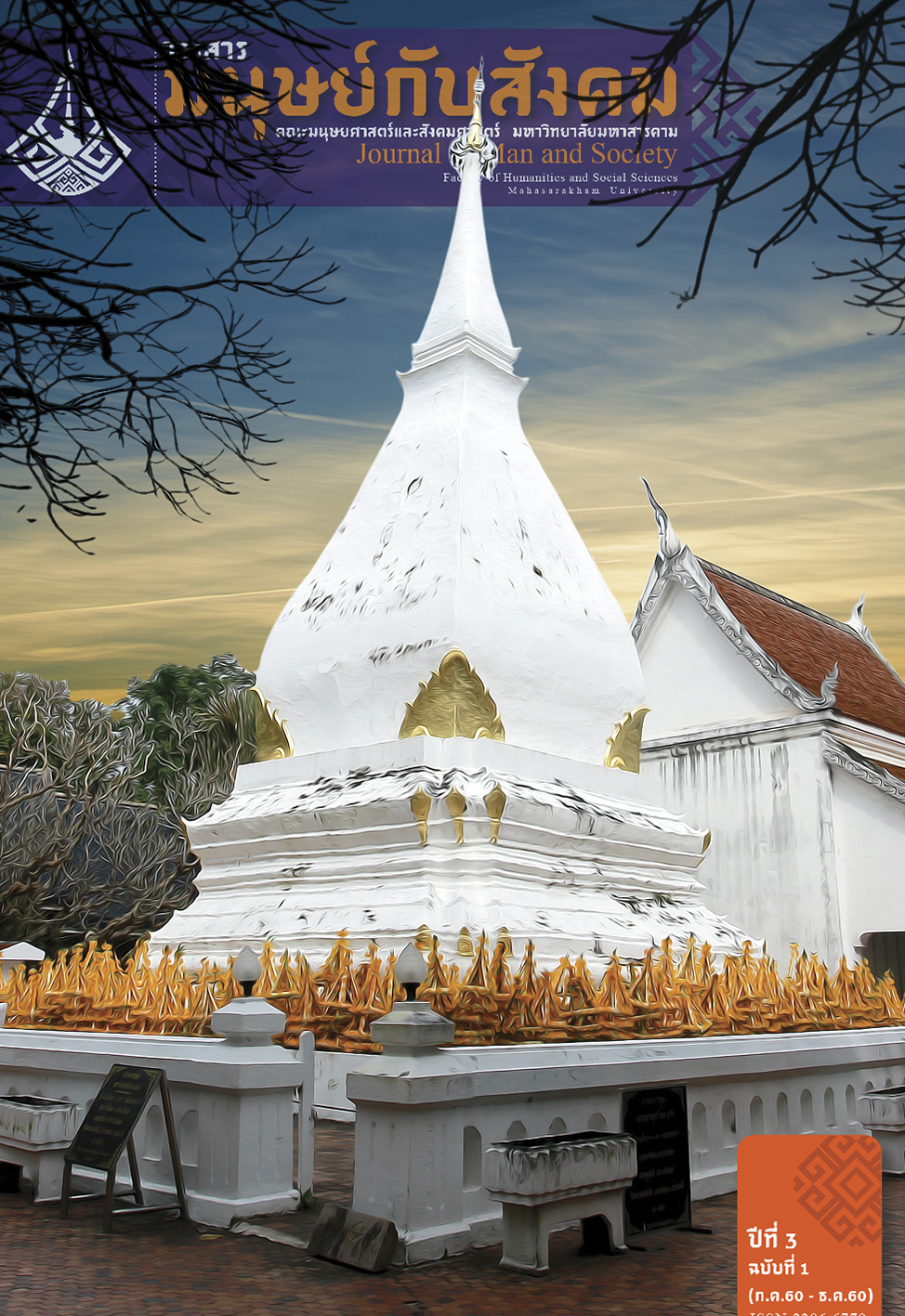Landscape Changes, Effects and Adaptation in Mae Klang Luang Village under Commoditization for Agro-tourism
Main Article Content
Abstract
Many communities has attempted to utilize their resources to develop agrotourism, which is able to influence landscape changes and livelihood. This research, thus, is to analyze landscape changes of Mae Klang Luang village incommoditization for tourism, as well as impacts and adaptation of the villagers to this phenomenon. The qualitative research was applied by conducting interviews with leaders, villagers from 75 households and 9 tourist entrepreneurs. Results found that villagershave gained economic benefits from utilizing original landscape and new artificial landscape as commodities by the promotion of some stakeholders in the area. Before the coming of agro-tourism as a part of livelihood existing, livelihood improvement enforced by such authorities, along with the utilization of social capital in natural resources conservation is rather significant to promote a fertile landscape as a potential attractive place in agro-tourism. At the rising age of agro-tourism, together with livelihood improvement according to social transformation, many villagers have divided some financial capitals from agriculture, inheritance, or land plot in adapting
themselves. However, the villagers should return to concern about the importance of social capital which has been used for the protection of natural capital, in order to maintain the landscape for agro-tourism effectively and dissolve the community
conflict that might occur in the future.
Article Details

This work is licensed under a Creative Commons Attribution-NonCommercial-NoDerivatives 4.0 International License.
เนื้อหาและข้อมูลที่ตีพิมพ์ลงในวารสารมนุษย์กับสังคม ถือเป็นข้อคิดเห็นและความรับผิดชอบโดยตรงของผู้เขียนซึ่งกองบรรณาธิการวารสารไม่จำเป็นต้องเห็นด้วยหรือร่วมรับผิดชอบใดๆ
บทความ ข้อมูล เนื้อหา รูปภาพ ฯลฯ ที่ได้รับการตีพิมพ์ในวารสารมนุษย์กับสังคม ถือเป็นลิขสิทธิ์ของวารสาร หากบุคคลหรือหน่วยงานใดต้องการนำทั้งหมดหรือส่วนหนึ่งส่วนใดไปเผยแพร่ต่อต้องอ้างอิงวาสาร
References
จีรพร ศรีวัฒนานุกูลกิจ. (2544). การท่องเที่ยวกับความเปลี่ยนแปลงในชุมชนชาวเขา.เชียงใหม่: สถาบันวิจัยสังคม มหาวิทยาลัยเชียงใหม่.
ไชยณรงค์ ปุยอรุณ, พันตรี. (2548). การเปลี่ยนแปลงภูมิทัศน์ชายแดนและปัญหาเขตแดนไทย-พม่าบริเวณแนวเทือกเขาแดนลาวและถนนธงชัย. วิทยานิพนธ์วิทยาศาสตรมหาบัณฑิต สาขาวิชาภูมิศาสตร์ คณะสังคมศาสตร์ มหาวิทยาลัยเชียงใหม่.
ธารารัตน์ สุนทรวิภาต. (2554). การท่องเที่ยวเชิงเกษตร และการปรับตัวของคนในชุมชนปางมะโอ: กรณีศึกษาหมู่บ้านปางมะโอ ตำบลวังเงิน อำเภอแม่ทะ จังหวัดลำปาง. การค้นคว้าอิสระ วิทยาศาสตรบัณฑิต สาขาวิชาภูมิศาสตร์ คณะสังคมศาสตร์ มหาวิทยาลัยเชียงใหม่.
ปิ่นแก้ว เหลืองอร่ามศรี. (2554). มโนทัศน์การดำรงชีพ. เชียงใหม่: คณะสังคมศาสตร์มหาวิทยาลัยเชียงใหม่.
เผ่าไทย สินอำพล. (2559). ภูมิศาสตร์มนุษย์. เชียงใหม่: ภาควิชาภูมิศาสตร์ คณะสังคมศาสตร์ มหาวิทยาลัยเชียงใหม่.
ไพฑูรย์ พงศะบุตร. (2536). ภูมิทัศน์และภูมิภาพ: ศัพท์บัญญัติของคำว่า landscape.จดหมายข่าว ราชบัณฑิตยสถาน, 3(29).
รัฐนันท์ พงศ์วิริทธิ์ธร. (2558). แนวทางการพัฒนาการท่องเที่ยวเชิงเกษตรเพื่อความยั่งยืนโครงการหลวงปางดะ. วารสารเทคโนโลยสีรุนารี Suranaree Journal of Social Science, 9(1), 19-35.
วรรณา วงษว์านชิ. (2546). ภูมิศาสตร์การท่องเที่ยว. กรุงเทพมหานคร: ภาควิชาภูมิศาสตร์คณะสังคมศาสตร์ มหาวิทยาลัยศรีนครินทรวิโรฒ.
วันทนา ฉิมบ้านดอน. (2551). การท่องเที่ยวเชิงเกษตรในตำบลบางใบไม้ อำเภอเมืองสุราษฎร์ธานี. วิทยานิพนธ์วิทยาศาสตรมหาบัณฑิต สาขาวิชาภูมิศาสตร์คณะสังคมศาสตร์ มหาวิทยาลัย เชียงใหม่.
วิไลวรรณ วิไลรัตน์. (2556). การเปลี่ยนแปลงภูมิทัศน์ของชุมชนเกาะยอในบริบทของการพัฒนาภูมิภาค. วิทยานิพนธ์วิทยาศาสตรมหาบัณฑิต สาขาวิชาภูมิศาสตร์คณะสังคมศาสตร์ มหาวิทยาลัยเชียงใหม่.
ศิโรรัตน์ หอมนาน. (2547). ศักยภาพการพัฒนาการท่องเที่ยวเชิงเกษตรหมู่บ้านรอบบริเวณศูนย์ศึกษาการพัฒนาห้วยฮ่องไคร้อันเนื่องมาจากพระราชดำริ. วิทยานิพนธ์วิทยาศาสตรมหาบัณฑิต สาขาวิชาส่งเสริมการเกษตร คณะเกษตรศาสตร์มหาวิทยาลัยเชียงใหม่.
ศูนย์ประสานงานเครือข่ายการท่องเที่ยวโดยชุมชน. (2555). แม่กลางหลวง. [ออนไลน์]. ได้จาก:https://thaicommunitybasedtourismnetwork.wordpress.com/
cbtcommunity/ northcommunity/maeklangluang/. [สืบค้นเมื่อ วันที่ 15กันยายน 2559].
อริยา อรุณินท์. (2548). เทศกาล งานเมือง: ภูมิทัศน์วัฒนธรรมเพื่อความเป็นเมืองน่าอยู่.วารสารวิชาการ คณะสถาปัตยกรรมศาสตร์ จุฬาลงกรณ์มหาวิทยาลัย,2548(1), 23-50.
Anderson, J. (2010). Understanding cultural geography: places and traces. London;New York: Routledge.
Castree, N. (2003). Nature. New York: Routledge.
Chambers, R. and Conway, G. R. (1991). Sustainable Rural Livelihoods: PracticalConcepts for the 21st Century, IDS Discussion Paper 296, IDS (Instituteof Development Studies), UK.
Crouch, D. (2006). Tourism, consumption and rurality. In Cloke,P., et al. (Eds.),Handbook of Studies. London: SAGE Publication Ltd.
Mohan, G. (2014). Participatory Development.In Desai, V. and Potter, R. B. (Eds.),The Companion to Development Studies. Oxon: Routledge.
Whatmore, S. (1999). Hybrid Geographies: rethinking the ‘human’ in human geography, In Massey, D., et al. (Eds.), Human Geography Today.
Cambridge: Polity Press.


